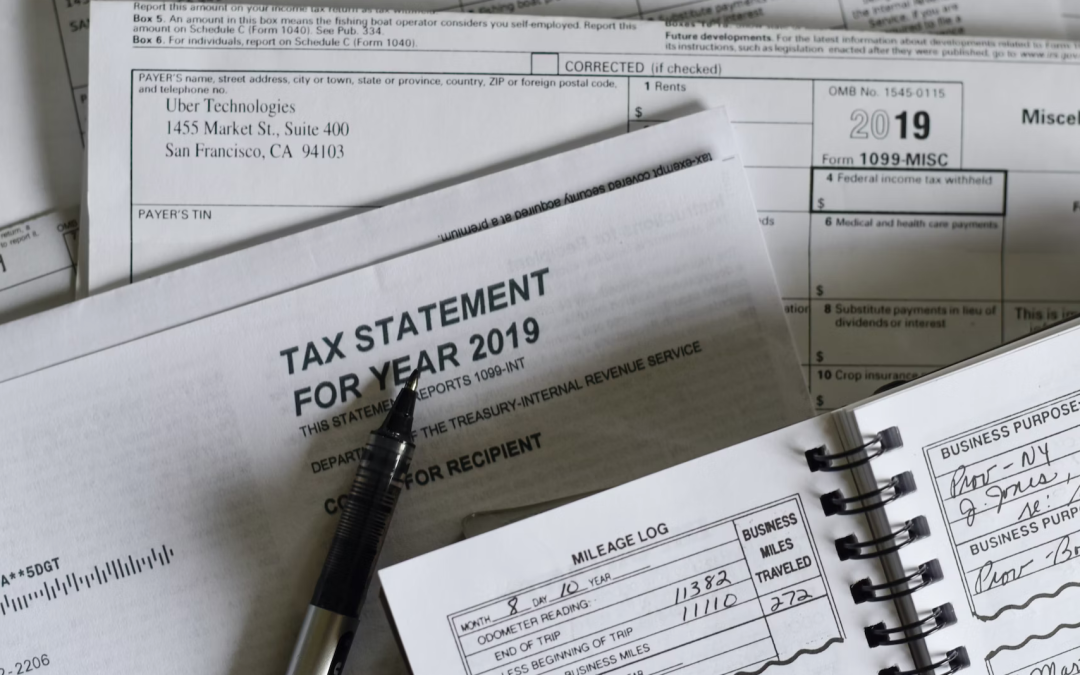
by Andrea Carson | Sep 20, 2023 | Entrepreneurship, Finances, Taxes
As an entrepreneur, managing your business expenses is a critical component of maintaining a healthy financial foundation. Keeping a close watch on your expenses not only ensures that you stay within budget but also provides valuable insights into your business’s financial health and growth potential. In this blog, we’ll delve into effective strategies and tools to help you stay on top of your business expenses, streamline your financial processes, and set the stage for success.
1. **Create a Dedicated Business Account**
Separating your personal and business finances is essential. Open a dedicated business bank account to ensure that all your business transactions are centralized and easy to track. This separation simplifies record-keeping and prevents confusion when categorizing expenses, making it easier to prepare accurate financial statements come tax time.
2. **Digital Expense Tracking Tools**
Embrace technology by using digital expense tracking tools tailored for entrepreneurs. Apps like QuickBooks, FreshBooks, and Expensify offer user-friendly interfaces that help you record expenses, categorize them, and generate detailed reports. These tools can automate data entry, reducing the likelihood of manual errors and saving you time.
3. **Organize Receipts Digitally**
Say goodbye to the hassle of paper receipts piling up in your workspace. Utilize apps like Evernote, Shoeboxed, or Adobe Scan to capture and store digital copies of your receipts. This practice not only saves physical space but also makes it easier to search for and retrieve receipts when needed.
4. **Set Up Expense Categories**
Establish a clear and detailed system of expense categories that align with your business’s activities. Categories might include marketing, office supplies, travel, utilities, and more. Assign each expense to the appropriate category as soon as it’s incurred to streamline the tracking process and gain a comprehensive view of where your money is going.
5. **Regularly Reconcile Accounts**
Frequently reconcile your business accounts to ensure that your recorded expenses match your bank statements. This practice helps identify any discrepancies or errors early on, preventing financial confusion down the line. Reconciliation also aids in spotting potential fraudulent activities and maintaining the accuracy of your financial records.
6. **Implement a Receipt Approval Process**
If you have employees or contractors making business-related purchases, establish a receipt approval process. Require them to provide receipts and detailed explanations of their expenses before reimbursement. This not only encourages responsible spending but also adds an extra layer of accountability.
7. **Schedule Regular Expense Reviews**
Set aside time on a weekly or monthly basis to review your business expenses. Analyze spending patterns, identify areas of overspending, and make informed decisions about where to cut back or allocate more funds. Regular expense reviews also allow you to gauge the effectiveness of your budgeting strategies.
8. **Plan for Taxes**
Don’t wait until tax season to organize your expenses. Throughout the year, keep track of deductible expenses, such as office supplies, travel expenses, and professional services. This proactive approach makes tax preparation less overwhelming and maximizes your potential deductions.
Maintaining a clear record of your business expenses is a fundamental practice that contributes to the success of your entrepreneurial journey. By establishing organized processes, leveraging digital tools, and staying vigilant about tracking your spending, you’ll gain a deep understanding of your business’s financial landscape. This knowledge empowers you to make informed decisions, optimize your budget, and ultimately pave the way for sustainable growth and profitability. Remember, the effort you invest in tracking your business expenses today will pay off in the form of financial clarity and a solid foundation for the future.

by Andrea Carson | Aug 23, 2023 | Entrepreneurship, Finances, Taxes
Keeping Good Financial Records for Your Small Business: A Comprehensive Guide
Maintaining accurate and organized financial records is crucial for the success and growth of any small business. Good financial records not only help you track income and expenses but also enable you to make informed decisions, prepare for taxes, and demonstrate financial health to potential investors or lenders. In this comprehensive guide, we’ll outline essential steps to keep good financial records for your small business.
1. Separate Business and Personal Finances
The first and most critical step is to separate your business and personal finances completely. Open a dedicated business bank account and use it exclusively for business transactions. This separation ensures that your financial records remain clear and reduces the risk of commingling funds, which could lead to tax and accounting complications.
2. Choose the Right Accounting System
Selecting the right accounting system is vital for efficient financial record-keeping. Consider using accounting software like QuickBooks, Xero, or Wave, which offers user-friendly interfaces and various features to track income, expenses, invoices, and financial reports. An appropriate accounting system will streamline your record-keeping process and provide valuable insights into your business’s financial performance.
3. Maintain Organized Receipts and Invoices
Keep a record of all receipts and invoices related to business transactions. Organize them by date and category, such as office supplies, travel expenses, or equipment purchases. Digitize paper receipts whenever possible and store them securely in the cloud or on a dedicated server to prevent loss.
4. Track Income and Expenses Regularly
Consistency is key in maintaining good financial records. Set a schedule to record income and expenses regularly, whether it’s weekly, bi-weekly, or monthly. Use your chosen accounting software to input transactions promptly, and reconcile bank statements to ensure accuracy.
5. Create and Manage a Chart of Accounts
A chart of accounts is a list of categories used to classify income, expenses, assets, and liabilities. Organize your chart of accounts to match your business’s specific needs and structure. This system will help you categorize and track financial transactions more effectively.
6. Monitor Cash Flow
Understanding your business’s cash flow is critical to making informed financial decisions. Monitor incoming and outgoing cash regularly to identify potential cash flow gaps and take proactive measures to address them. Positive cash flow is essential for the sustainability and growth of your small business.
7. Reconcile Bank Accounts and Statements
Regularly reconcile your business bank accounts with your accounting records to ensure accuracy and identify any discrepancies. This process helps catch errors, duplicate transactions, or missing entries that may affect your financial statements.
8. Prepare Financial Statements
Generate essential financial statements regularly, including income statements, balance sheets, and cash flow statements. These statements provide a snapshot of your business’s financial health and aid in identifying trends and areas that require attention.
9. Keep Track of Tax Obligations
Stay organized with your tax obligations to avoid potential penalties or missed deadlines. Maintain records of payroll taxes, sales taxes, and other applicable taxes. Prepare and file tax returns accurately and on time.
10. Back Up Your Financial Records
Regularly back up your financial records to protect against data loss due to hardware failure, theft, or cyber-attacks. Store backups securely and consider using cloud-based solutions for added protection.
11. Seek Professional Assistance
If financial record-keeping becomes overwhelming, consider seeking professional assistance from an accountant or bookkeeper. An experienced professional can help set up your financial records, guide you on best practices, and provide valuable insights into your business’s financial performance.
Conclusion
Maintaining good financial records is an essential part of running a successful small business. By following these steps and implementing effective financial record-keeping practices, you can gain valuable insights into your business’s financial health, make informed decisions, and position your small business for growth and success. Regularly review your financial records, stay organized, and seek professional help when needed to ensure your financial records are accurate, reliable, and serve as a solid foundation for your business’s financial success.

by Andrea Carson | Jun 14, 2023 | Entrepreneurship, Finances
One of the major ways to save funds in your enterprise is through intelligent tax financial savings. Each yr, many tax deductions are provided by the IRS, which can not solely reduce your taxable but can also reduce the income related to the self-employment tax. Sometimes the difference between an enterprise making gains and surviving could be managing one’s taxes.
In. this article, we discuss ways to help you relieve stress from your business’ taxes and help save you some funds. Ultimately, success is not measured by what you make but by what you keep.
Fund a Retirement Plan
Self-employed individuals or small company vendors have more retirement planning alternatives than any other. Like everyone else, individuals below one or two of these categories will have access to the Traditional IRA of $5,500 annually. An IRA is an individual retirement account that allows you to save finances for your retirement by utilizing taxes to your advantage.
An enterprise with one hundred or fewer staff is provided the SIMPLE IRA (Savings Incentive Match Plan for Employees) plan. The conventional IRA of $5,500 can be mixed with different retirement plans, such as the SEP IRA or the 401(K), which can result in enabling you to contribute up to $55,000 each yr. Those who are over 50 can have access to even a lot bigger contribution limits. You can put away as a lot as $150,000 if you can get the 401(K) jointly with a Cash Balance Pension Plan.
You can reduce your tax bill when you are income-wise. Contributing to the plans pointed out above will, without a doubt, get a tax deduction. That can gain those companies trying to turn into pass-through entities, which can help them get a 20 % tax deduction on their web income.
Under the “phase-in rule,” your deductions are lowered pro-rate if you are a single filer, and your taxable is extra than $157,500, and if you are a joint filer (meaning you are married) and your taxable exceeds the $315,000 threshold. The phase-in becomes finished for single filers, whose is $207,500, and for joint filers, whose is $415,000
If you have taxable extra than these upper thresholds, neglect getting that 20% tax deduction of a pass-through entity. But if you contribute to the retirement accounts, your taxable could be less than these thresholds, making you a qualified pass-through entity. It’s just like killing two birds with one stone.
Employ a Family Member
Hiring a family member in your small enterprise is one of the most useful ways to reduce taxes. Business vendors can even engage their kids. No, this way, you won’t impose child labor on your children, but you will educate them on the worth of hard-earned funds. The IRA allows for many different options, which can give a haven to you from taxes.
You have to make yes that you can present that your child’s earnings come from justifiable enterprise services. Typically, the kids are put in a lower tax bracket, so paying them would decrease the tax burden on your family. For example, if someone is a sole proprietor, they wouldn’t have to pay the Medicare and social security taxes on their child’s wages.
You can have your kids open a ROTH IRA with their earnings, including further credit. For three years, from 15 to 17 years, if a child places $5,500 into a ROTH IRA and doesn’t ever contribute once more. Every yr, they would earn 10% of the donated amount, and by the age of 70, that $16500 would have piled up to a tremendous $25. million. Consider how a lot of an influence compound curiosity would have on funding that would have been opened when someone was a teenager.
Deduct Travel Expenses
When you use your vehicle for your business, you can get a deduction from expenses related to that vehicle, like mileage, lease, or upkeep. You might be thinking, what percentage of the mileage of your vehicle can be allotted to your business? Well, it doesn’t matter what the price is. You must word the mileage and apply it to your yearly auto expenses.
For the deductions related to your vehicle, the IRS provides two ways. First, track your true expenses and then subtract the percentage associated with your enterprise. The second method tells you to word your yearly mileage and then apply the tax deductions on those miles. For the yr 2020, the commonplace mileage price is 575. cents per mile
Let’s assume you drive a Range Rover. For its lease, you pay $1500 monthly, driving 10,000 miles in your Rover in a yr. Of these 10,000 miles, 80% come below relocating to work. If you used the first method, in which you have to maintain track of your true expenses, you would spend $18,000 in a yr for your lease plus different expenses related to the fuel consumed and any extra upkeep costs. You would get a tax deduction of about $14,400, solely for your lease. On the different hand, if you used the commonplace mileage price deduction method, you would solely be able to get a deduction of $4,600
Deduct Your Home Office
If you are a small enterprise proprietor or self-employed and work from home, you might be eligible for the “home office deduction.” There is a huge myth regarding the dwelling office deduction. Many individuals believe that the dwelling office deduction mostly results in an audit. You don’t have to fear anything if you qualify for this deduction and have good information. According to IRS publication 587, your house must meet two requirements to qualify for a deduction. First, half of your house should be exclusively and repeatedly used for business, and second, you must prove that your dwelling is used as your principal place of business.
Time Business Income and Expenses
A timing enterprise strikes you from one yr to the next. To use this procedure fully, determine which yr will have the highest taxes because your taxes will rely on two things: the of your enterprise and the premiums on enterprise taxes. To reduce your web for a specific year, move your expenses to the yr with bigger taxes.
Review your current expenditures earlier than the end of each year, and if decreasing can give you some benefits, then pay some of the amounts in advance. By stocking up on supplies, you can decrease and increase your sales.

by Andrea Carson | Jun 7, 2023 | Entrepreneurship
How frequently do entrepreneurs speak to their accountants and feel even more confused than they have been earlier? This is most likely the case with several entrepreneurs and managers without a background in enterprise or accounting.
To aid business owners through the arduous process of managing their accounting resources, we have come up with a checklist of common accounting terms that most enterprise managers come throughout during their time as entrepreneurs.
Terms in the Balance Sheet
As we have studied above, the balance sheet is one of the two most common statements produced by all varieties of enterprise vendors. The balance sheet accommodates a set of confusing terms that can be difficult to understand for business owners with limited acumen of accounting terms and what they mean in an economic context. The most frequent phrases used in the stability sheet and their definitions are:
Accounts Payable
Accounts payable defines all the expenses a business incurs but hasn’t yet paid. The accounts payable balance is recorded as a legal liability in the balance sheet, and the debt owed due to it has to be paid back. Accounts payable include payments to vendors and other lenders, which haven’t but been made.
Accounts Receivable
Accounts receivable are the exact reverse of accounts payable. These accounts include all the sales that a business has made but haven’t but collected payment on. An example of this from a property manager’s perspective would be uncollected property management fees from a landlord for a period that you have provided your services. This account is listed on the balance sheet as an asset and can easily be converted to cash on a short-term basis since you have already provided the services required.
Accrued Expenses
An accrued expense contains all expenses that have been incurred by a business but haven’t been paid. Property managers tend to come through a lot of accrued expenses, as they pay for expenses after they have been incurred. An instance of this would be the cost charged by an electrician for working repairs on a property. The expense has been incurred, but if it hasn’t been paid for, it will be recorded as an accrued expense.
Asset
Assets are an integral part of the balance sheet and consist of something the business owns and has a monetary value. Assets are listed in the kind of liquidity, with the most liquid assets being mentioned on top and others following. Since cash on hand is the most liquid asset a business can own, it is almost always mentioned near the top of the balance sheet.
Book Value
Every asset owned by the business is depreciated over time to adjust for the value it loses over its period of use. The associated net publication value of the asset is computed by deducting the accumulated depreciation of the assets from the original value to mark the asset at its original value at a given time. For instance, a property manager purchased a laptop for their workplace 2 years ago. The laptop will be valued at far less now than when the property manager first purchased it. Hence, this depreciation is adjusted for in the balance sheet through an appropriate net book value.
Equity
Equity consists of the money invested into the business from interior and exterior sources. Internal sources include capital investments from the owner and shareholders, whereas exterior sources include long-term loans and debentures from personal and recognized lenders. If you can recall the accounting equation, you can tell that equity is what is left after liabilities are deducted from assets. Equity is the portion of the company owned by vendors and investors.
Inventory
Inventory is the term used to classify all assets purchased by a company to sell to their customers but stay unsold. Inventory can come in three different forms for most manufacturing businesses. The first includes finished goods, which is common for some retailers, the second type includes work in progress, which consists of inventory nonetheless in the manufacturing process at the time of recording these entries; and the final style consists of raw materials, which are but to enter the manufacturing process but are currently in possession of the business.
Liability
Legal responsibility is the accumulation of all accounts owed by an organization. Liabilities include accounts payables, loans, payroll loans, and accrued expenses.
Terms in the Income Statement
The revenue assertion or the revenue and loss assertion is the second of the two most frequent financial statements recorded by organizations today. Some of the terms most commonly used in a revenue assertion include:
Cost of Goods Sold
The rate of items sold, or COGS, are all expenses immediately associated with manufacturing or procuring a product or service. The cost of goods sold measures the direct costs of manufacturing items ultimately sold for earnings new release. An instance of COGS in most companies would be the rate of supplies incurred or the rate of direct labor done for delivering a service or for manufacturing goods.
Depreciation
Depreciation is recorded as an expense in the revenue assertion and accounts for the value misplaced in an asset over time. Generally, depreciation impacts both the income statement and the balance sheet, so it is recorded as an adjusting entry rather than being mentioned in the trial balance. The depreciation for a period is calculated through either the straight-line method or by reducing the balance method. Both methods use a fixed percentage to calculate the value an asset has lost over a year, which is then recorded in the income statement as an expense. This is a non-cash expense, which is why it does not have an almost immediate impact on the financial standing of an organization.
Gross Profit
The Gross Profit measures an organization’s direct profitability in dollars without considering the other overhead expenses incurred by the business. The Gross Profit is calculated by subtracting the total cost of goods sold from the revenue generated during the same period.
Gross Margin
Gross margin or GM is a percentage ratio calculated by taking your gross profit for a period and dividing it by the revenue for the same period. The Gross Profit Margin represents the profitability that a company has achieved through revenue.
Net Income or Net Profit
The net income or net profit of a business is also earned in dollars and is usually the final profit that the owner keeps to themselves, is shared among partners, or is paid as dividends to shareholders – based on the organization’s structure. The net profit is calculated by taking the gross profit (calculated by subtracting COGS from total sales) and subtracting all expenses recorded during the given period, including overheads, wages, energy costs, depreciation, and taxes. A net income is reported if the resulting profit is a positive value, while a loss is reported if the final figure is negative. A loss means that the organization has failed to generate any profit during that period and that expenses are more than the sales generated.
Net Loss
The net loss of a business is usually the final loss that the owner bears by themselves or shares among partners – based on the organization’s structure. The net loss is calculated by taking the gross profit (calculated by subtracting COGS from total sales) and all expenses recorded during the given period, including overheads, wages, energy costs, depreciation, and taxes. A net income is reported if the resulting profit is a positive value, while a loss is reported if the final figure is negative. A loss means that the organization has failed to generate any profit during the period and that expenses exceed the sales generated.
Net Margin
The net margin is the percentage of the net profit from its revenue or sales figure. The net margin is calculated by dividing the net income for a period by the net sales for the same period and multiplying it by 100. The final percentage will display the profitability of a business about its sales.
General Terms
There are several other normal phrases used in accounting apart from the ones pointed out in the two most important financial statements. Some of these important general phrases include:
Accounting Period
An accounting period is mentioned in all financial statements – balance sheet, statement of profit and loss, and statement of cash flows. The accounting period is usually used to communicate to stakeholders and other readers the period to which the financial statement relates.
Allocation
The term allocation describes assigning funds and investments to different financial periods and accounts. For instance, a cost can be allocated across several periods or multiple departments. An expense like insurance must be allocated over multiple months, while administrative costs must be assigned across all departments in a multi-department firm.
Business Entity
A business entity is a legal term used to refer to a business. Business entities can come in all shapes and sizes and feature different legal structures, types, and profit-sharing structures. Common company formations followed in organizations today include partnership, sole proprietorship, S-Corp, C-Corp, and Limited Liability Corporation or LLC. Every one of these entities carries a unique set of laws, requirements, and tax implications.
Cash Flow
Cash flow is the term used to describe the inflow and outflow of money within a business. The net cash flow for a given period can be calculated by taking the beginning cash balance for a year and subtracting it from the balance reported at the end of the year. A positive cash balance indicates that more cash has flown across a business during a given period. A negative balance indicates the opposite – more cash has flown out of the business than what has come in.
General Ledger
The general ledger is where an accountant would record all your entries. When recording these entries in your general ledger, all debit entries will be on the left, and all credit entries will be on the right. All of these entries are then summarized in your trial balance, which shows the total of your credit and debit balances. If you have performed the entire double-entry method correctly without any errors, then your debit side of the trial balance should be the same as your credit side.
Recording transactions through the double-entry method gives you a comprehensive and detailed view of your financials. You can use this view to improve your understanding of these entries.
Bookkeeping
The term bookkeeping dates back to the days before computers were mainstream in accounting management. During this period, books would be used to record statements daily. Bookkeeping is defined as maintaining your day-to-day transactions, regardless of whether they are transcribed in a book or a computer.
Cash Accounting
Cash Accounting is a various methodology of accounting to accrual accounting. In this method, you file funds when you truly pay expenses for them, not when the expense is incurred. Most property managers primarily follow this accounting methodology at this time, and is in play throughout companies in the industry.

by Andrea Carson | May 31, 2023 | Entrepreneurship
Entrepreneurs yearn for the struggle to manage their own companies. The battle often leads to many benefits but can sometimes lead to a corridor of endless darkness. Thus, while launching your well-thought-out startup, you must plan a sparkling exit strategy for the tough times.
Most startups often start their new organization without a proper exit strategy. Everybody likes the period of high, with the money flowing in and the finances meeting all expenditures. However, business plans can only succeed by outlining a proper exit strategy for all.
An exit strategy only comes in handy when things go south. Your exit strategy can be helpful in several places. For instance, you can use your exit strategy to find the best ways to jump from one startup to another. We might have the resource for all entrepreneurs looking for an exit strategy.
For all those who plan for the future and those who don’t but should because planning is the best way out, the following four exit strategies are deemed to give a feasible return on the effort and capital that you invest:
Liquidation
Liquidation is the process of finishing business. It means selling the company’s assets and realizing all the tangible and intangible gains. The money made from selling the assets and realizing the profit would be used to repay all the business loans. The remaining leftovers will be distributed amongst the owners and the shareholders.
The process is straightforward and free of any hassles. There is no transfer of power, so everything phases out simply for you.
Just Bleed the Company Dry
One exit strategy gaining popularity amongst entrepreneurs is to bleed the company dry. That would mean that you shower yourself with a luxurious salary and bonuses of all sorts. It cannot turn out perfectly in a public company, but it is all okay in a private company.
Rather than having to bear the hassle of reinvesting the money into the business, a decent exit strategy can be to take out a satisfying chunk and enjoy the spoils of your brainchild.
Plan an Acquisition
An acquisition is when another company buys yours at a mutual selling price. The acquisition price is set after a detailed dialogue and includes calculating the working capital and the goodwill the acquisition would bring. Considering that the person from the other party doing the discussions for the purchase is not necessarily the owner, you can bargain a deal with them, making the acquiring company flex their bank accounts.
Put a Friendly Person in Charge
Handing the business to a friendly friend can be a decent exit strategy. One such example can be giving the company to your children, who will, in the worst-case scenario, eventually fight for it amongst each other and lead the company to its downfall. This option ensures you keep making money even after implementing the exit strategy.
Suppose you have become emotionally attached to a business. In that case, the best way to plan an exit strategy is to put a friendly person who shares your passion in charge of the business rather than selling it to someone else. It will broaden your attachment without burdening you in any way.





